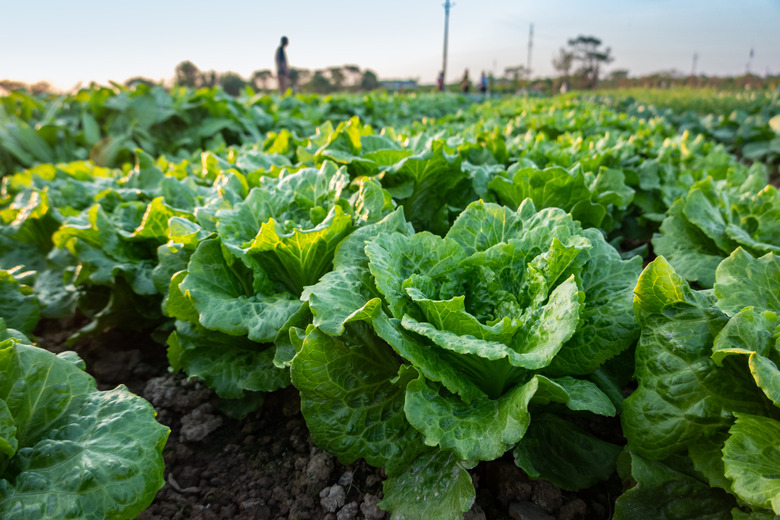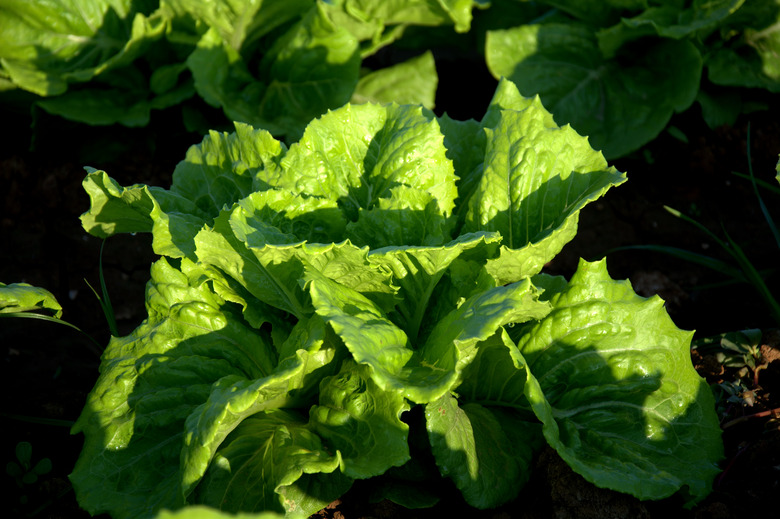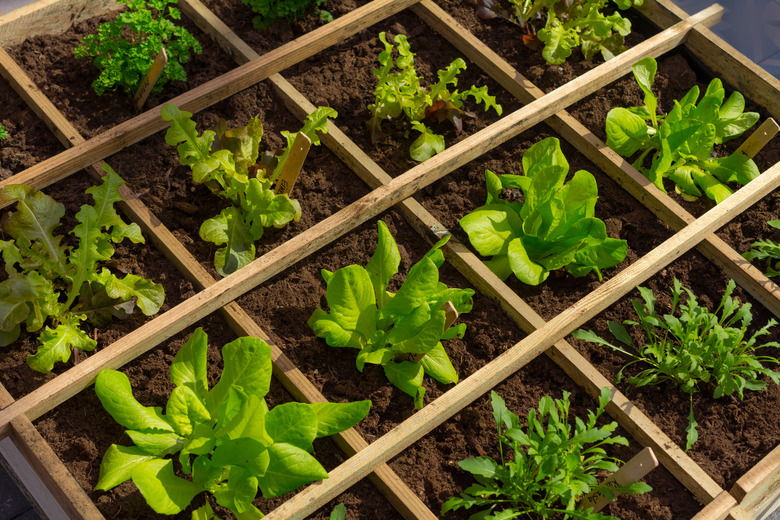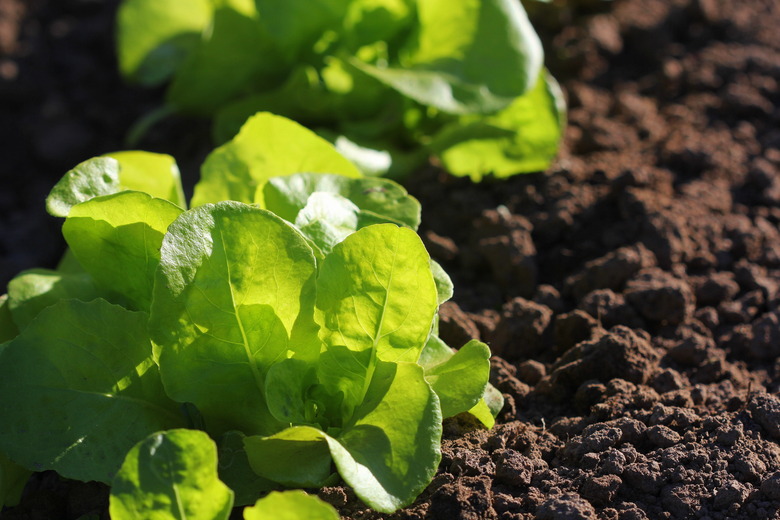How To Grow Lettuce
We may receive a commission on purchases made from links.
Lettuce (Lactuca sativa) is an important member of the edible garden across virtually all of the United States, with different varieties within the species. A key component for salads and sandwiches, the various lettuce types are often grouped into four basic categories based on the appearance and arrangement of the edible leaves:
- Crisphead or iceberg lettuce (Lactuca sativa var. capitata) is the classic tightly headed lettuce with a compact, round form.
- Butterhead lettuce (Lactuca sativa var. capitata) is still a head lettuce, but rather than a tight, cabbage-like sphere, these cultivars of S. capitata form a much looser head. Boston lettuce and bibb lettuce fall into this category.
- Looseleaf lettuce (Lactuca sativa var. crispa) does not form heads at all but simply grows up from the ground in soft, wavy leaves.
- Romaine lettuce (Lactuca sativa var. longifolia) is sometimes known as cos lettuce. It has crisp, textured leaves with prominent veins running down the center.
While there are differences in how the various categories of lettuce are planted and harvested, all lettuces are cool-weather vegetables that grow best when days are short and nights are long. In many regions, it is planted twice during each growing season — once in the spring immediately after the danger of frost has passed and then again in late summer or early fall for a late-fall to early winter harvest. In other regions with just the right climate, lettuce can be planted at various times to provide a harvest for most of the year.
Because the looseleaf lettuces are "cut-and-come-again" types that continue to produce new leaves after harvest begins, they are a good choice for home gardens. The head lettuces must fully mature into well-defined heads before harvesting. They take up a fair amount of space in the garden, and if pests or diseases strike, the entire head is ruined. Head lettuces are worth growing if you have plenty of space, but nearly all gardeners will have good luck with the looseleaf and romaine types of lettuce.
Best Uses for Lettuce
Best Uses for Lettuce
Lettuce is a must-have vegetable if you enjoy salads and sandwiches. If you fall into that category, you may even want to plant several different types of lettuce in various colors and textures to have plenty on hand. Lettuce is a good choice if you have areas of the garden that experience some shade — those spots where pure sun-loving vegetables don't grow as well.
Lettuce works well for in-ground gardens, raised beds and containers such as planter pots. Generally growing no more than 6 to 12 inches, lettuce is a good choice for the front perimeter of the vegetable garden in front of taller vegetables. Rather than long rows, lettuce is often planted in small squares or patches where it can be easily harvested. In hot climates, planting lettuce so it is shaded by taller vegetables can keep it from sending out flower heads (bolting) too early.
Lettuce is an excellent choice for growing in cooler climates in the spring or fall, when the days are shorter. Growing this cool-season vegetable in warm climates can be challenging at best, but lettuce will thrive in cooler climates.
Finally, lettuce is a good choice for gardeners who don't want to spend a lot of time and effort since it is relatively easy to grow. Children very much enjoy sowing looseleaf lettuce seeds and watching them sprout into bright-green leaves in a matter of a few days.
How to Grow Lettuce
How to Grow Lettuce
Starting Lettuce From Seed
Starting Lettuce From Seed
Lettuce grows quite easily from seeds, so this is the method by which it is usually planted. The seeds can be sown directly into the garden, where they will sprout in five to 10 days and mature in four to nine weeks, or you can sow the seeds indoors in cups filled with vermiculite about seven weeks before the last frost date. Indoor seeds will sprout in just two or three days if kept moist and warm. The indoor seedlings can be transplanted outdoors when the seedlings are about half grown.
Scatter the seeds over the potting mix or garden soil and then cover them with 1/4 inch of soil. Mist regularly to dampen the soil until the seeds sprout. As the seedlings grow, thin them out to the desired spacing (about 4 inches apart for looseleaf varieties, 6 inches for romaine and 10 to 12 inches for head lettuce).
Keep lettuce plants consistently moist but not soggy as they grow. Ground-level watering is better than overhead watering.
Starting Lettuce From Seedlings
Starting Lettuce From
Seedlings
Although many people prefer to start lettuce by sowing seeds, nursery-grown seedlings are also available in nursery packs. Plant them in the desired location right around the time of the last expected frost. Spacing will depend on the type of lettuce you are growing. Leaf lettuces are planted about 4 inches apart, romaine lettuces about 6 to 8 inches apart and head lettuces 10 to 12 inches apart.
Water the plants deeply once a week and strive for ground-level watering rather than overhead watering that dampens the leaves.
In What Zone Does Lettuce Grow Best?
In What Zone Does Lettuce Grow Best?
Lettuce is a true annual crop that can be grown in USDA zones 2 to 11. However, it will do best in areas where the summer temperatures are fairly mild. In warmer zones, you may have a fairly short window during which lettuce will grow well: spring to early summer or fall to early winter. As temperatures rise in summer, lettuce plants tend to "bolt," or shoot up flower stalks to produce seed heads. Once this happens, edible lettuce production is over, and you are best advised to remove the plants and use the space for planting a warm-weather vegetable.
When Should You Plant Lettuce?
When Should You Plant Lettuce?
Growing lettuce requires soil temperatures that are at least 40 degrees Fahrenheit, and this ground temperature is reached at different times depending on where you live. In most regions, you should plant lettuce in late March to May. For fall crops, the planting time is August to mid-September. If you live in an area with freezing winter temperatures, a soil thermometer can determine when the ground is warm enough for planting lettuce.
If you are starting lettuce seeds indoors for spring planting, then sow them about six weeks before the last expected frost date in your area. The seedlings will be ready to transplant outdoors at precisely the right time.
Soil, Sunlight and Water Recommendations for Lettuce
Soil, Sunlight and Water
Recommendations for Lettuce
Lettuce grows best on fertile soil that is loose and well-draining. It prefers a neutral soil pH. It is a good idea to mix compost or other organic amendments such as peat moss into the soil a week or two before planting lettuce in the garden. Some gardeners like to blend compost or aged manure into the soil during the autumn before planting time the following spring.
Like most vegetables, lettuce prefers a sunny growing location, but like most leafy vegetables, it will also tolerate some shade. This can be a good plant to use in the corners of the vegetable garden where partial shade is an issue.
Water lettuce regularly by soaking the ground rather than spraying overhead. Overhead spraying that gets the leaves wet may foster fungal diseases. As a leafy vegetable, these plants require a good amount of nitrogen for good leaf growth. The soil should be high in organic material that provides plenty of nutrients, and you should also fertilize them with a high-nitrogen fertilizer about three weeks after seedlings appear and then fertilize them with half-strength fertilizer every two weeks. If you are an organic grower, fish emulsion is a good fertilizer to use for lettuce.
Keep the ground around your lettuce plants free of weeds that compete for water and nutrients. Keeping the ground free of debris will keep away slugs and snails, which love to feast on lettuce leaves.
How to Harvest Lettuce
How to Harvest Lettuce
Leafy varieties of lettuce are ready to harvest about six to seven weeks after seedlings appear, and head varieties are ready about eight to nine weeks after seed germination.
To harvest leafy lettuce varieties, you can harvest the outer leaves of each plant starting when the plant is about half grown, leaving the inner leaves to continue growing, or you can cut away the entire plant when it becomes fully mature. At the point when the plant begins to send up flower stalks, the leaves are usually too bitter and woody to eat. At this point, the plant can be pulled and discarded.
To harvest head lettuce, cut away the head by severing it at ground level with a sharp knife. Peel away any damaged outer leaves to retain the inner head. Lettuce should be eaten fresh within a few days of picking. It can be kept in the refrigerator until then. This is not a crop that can be dried, frozen or canned in any way.
Common Pests and Other Problems for Lettuce
Common Pests and Other
Problems for Lettuce
Lettuce is as delicious to many insect and animal pests as it is to humans, so you likely will face some ongoing battles for your crop.
- Snails and slugs leave ragged holes in the leaves of lettuce as they feed on them. They are most problematic when the ground around the plants is covered with leaves and debris under which they can hide, so keeping the ground clear will help prevent snail and slug infestations.
- Rabbits and woodchucks are especially fond of lettuce and can destroy an entire patch overnight. A variety of powdered and liquid repellents are available, but sturdy fencing is really the best prevention for rabbits, woodchucks and many other mammalian pests.
Cutworms can sever plants just above or just under ground level, or they may bore into head lettuce. The cutworms can be handpicked when you spot them, or you can sprinkle the ground around the plants with coffee grounds, eggshells or diatomaceous earth to deter them. There are also pesticides that kill cutworms, though you should always be careful when using chemicals on edibles. - Aphids are tiny, often very colorful insects that colonize in clusters on the leaves of lettuce. They gradually reduce the vigor of the plant as they suck out the inner juices of the leaves. Insecticidal soaps will kill aphids without leaving toxic residue.
Common Diseases for Lettuce
Common Diseases for Lettuce
Most of the common diseases that affect lettuce have no treatment other than to remove and destroy the affected plants.
- Verticillium wilt is a fungal disease that causes leaves to turn yellow and fall off. There is no treatment other than to remove and destroy the affected plants. Avoid replanting lettuce in the same area, as the fungal spores can remain in the soil for several years. For prevention, look for lettuce seeds that are bred to be resistant to verticillium and keep the ground free of debris that harbors fungal spores.
White mold is a fungal disease that causes the leaves of lettuce to wilt, turn yellow and die. It is more likely to appear during wet, humid weather, when you may notice white, cotton-like growth on leaves and stalks. Remove and destroy the affected plants. If you catch it early enough, a fungicide approved for edibles can also be used. - Mosaic virus is spread by aphids. The virus causes young leaves to roll up and become yellowish and stunted. There is no cure. Prevent it by planting seeds that are resistant to viruses.



